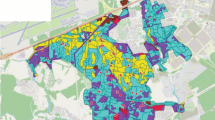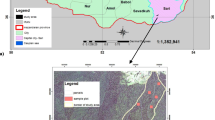Abstract
Object-based classification differentiates forest gaps from canopies at large regional scale by using remote sensing data. To study the segmentation and classification processes of object-based forest gaps classification at a regional scale, we sampled a natural secondary forest in northeast China at Maoershan Experimental Forest Farm. Airborne light detection and ranging (LiDAR; 3.7 points/m2) data were collected as the original data source and the canopy height model (CHM) and topographic dataset were extracted from the LiDAR data. The accuracy of object-based forest gaps classification depends on previous segmentation. Thus our first step was to define 10 different scale parameters in CHM image segmentation. After image segmentation, the machine learning classification method was used to classify three kinds of object classes, namely, forest gaps, tree canopies, and others. The common support vector machine (SVM) classifier with the radial basis function kernel (RBF) was first adopted to test the effect of classification features (vegetation height features and some typical topographic features) on forest gap classification. Then the different classifiers (KNN, Bayes, decision tree, and SVM with linear kernel) were further adopted to compare the effect of classifiers on machine learning forest gaps classification. Segmentation accuracy and classification accuracy were evaluated by using Möller’s method and confusion metrics, respectively. The scale parameter had a significant effect on object-based forest gap segmentation and classification. Classification accuracies at different scales revealed that there were two optimal scales (10 and 20) that provided similar accuracy, with the scale of 10 yielding slightly greater accuracy than 20. The accuracy of the classification by using combination of height features and SVM classifier with linear kernel was 91% at the optimal scale parameter of 10, and it was highest comparing with other classification classifiers, such as SVM RBF (90%), Decision Tree (90%), Bayes (90%), or KNN (87%). The classifiers had no significant effect on forest gap classification, but the fewer parameters in the classifier equation and higher speed of operation probably lead to a higher accuracy of final classifications. Our results confirm that object-based classification can extract forest gaps at a large regional scale with appropriate classification features and classifiers using LiDAR data. We note, however, that final satisfaction of forest gap classification depends on the determination of optimal scale (s) of segmentation.







Similar content being viewed by others
References
Asner GP, Keller M, Pereira RJ, Zweede JC, Silva JNM (2004) Canopy damage and recovery after selective logging in Amazonia: field and satellite studies. Ecol Appl 14(sp4):S280–S298
Baatz M (2010) eCognition user guide. Definiens imaging GmbH, Munich, p 23
Baatz M, Arini N, Schäpe A, Binnig G, Linssen B (2006) Object-oriented image analysis for high content screening: detailed quantification of cells and sub cellular structures with the Cellenger software. Cytom Part A 69(7):652–658
Benz UC, Hofmann P, Willhauck G, Lingenfelder I, Heynen M (2004) Multi-resolution, object-oriented fuzzy analysis of remote sensing data for GIS-ready information. ISPRS J Photogramm 58(3–4):239–258
Bonnet S, Gaulton R, Lehaire F, Lejeune P (2015) Canopy gap mapping from airborne laser scanning: an assessment of the positional and geometrical accuracy. Remote Sens 7(9):11267–11294
Boyd DS, Hill RA, Hopkinson C, Baker TR (2013) Landscape-scale forest disturbance regimes in southern Peruvian Amazonia. Ecol Appl 23(7):1588–1602
Chan JCW, Laporte N, Defries RS (2003) Texture classification of logged forests in tropical Africa using machine-learning algorithms. Int J Remote Sens 24(6):1401–1407
Clark ML, Clark DB, Roberts DA (2004) Small-footprint lidar estimation of sub-canopy elevation and tree height in a tropical rain forest landscape. Remote Sens Environ 91:68–89
Devagiri GM, Khaple AK, Mohan S, Venkateshamurthy P, Tomar S, Arunkumar AN, Joshi G (2016) Species diversity, regeneration and dominance as influenced by canopy gaps and their characteristics in tropical evergreen forests of Western Ghats, India. J For Res 27(4):799–810
He YH, Franklin SE, Guo XL, Stenhouse GB (2009) Narrow-linear and small-area forest disturbance detection and mapping from high spatial resolution imagery. J Appl Remote Sens 3(1):2701–2712
Hu TG, Xu JF, Zhang DR, Wang J, Zhang YZ (2013) Hard and soft classification method of multi-spectral remote sensing image based on adaptive thresholds. Spectrosc Spect Anal 33(4):1038–1042
Janssen LLF, Wel FJM (1994) Accuracy assessment of satellite derived land-cover data: a review. Photogramm Eng Remote Sens 60(4):419–426
Kanevan R, Gersonderolf F, Lutzjames A, Mcgaugheyrobert J, Bakkerjonathan D, Franklinjerry F (2011) Patch dynamics and the development of structural and spatial heterogeneity in Pacific Northwest forests. Can J For Res 41(12):2276–2281
Ke YH, Quackenbush LJ, Im JH (2010) Synergistic use of QuickBird multispectral imagery and LIDAR data for object-based forest species classification. Remote Sens Environ 114:1141–1154
Kim M, Madden M, Warner T (2008) Estimation of optimal image object size for the segmentation of forest stands with multispectral IKONOS imagery. Object-based image analysis. Springer, Berlin, pp 291–307
Koukoulas S, Blackburn GA (2004) Quantifying the spatial properties of forest canopy gaps using Lidar imagery and GIS. Int J Remote Sens 25(15):3049–3072
Kupfer JA, Runkle JR (1996) Early gap successional pathways in a Fagus-Acer, forest preserve: pattern and determinants. J Veg Sci 7(2):247–256
Malahlela O, Cho MA, Mutanga O (2014) Mapping canopy gaps in an indigenous subtropical coastal forest using high- resolution WorldView-2 data. Int J Remote Sens 35(17):6397–6417
Möller M, Lymburner L, Volk M (2007) The comparison index: a tool for assessing the accuracy of image segmentation. Int J Appl Earth Obs 9(3):311–321
Muscolo A, Bagnato S, Sidari M, Mercurio R (2014) A review of the roles of forest canopy gaps. J For Res 25(4):725–736
Negrón-Juárez RI, Chambers JQ, Marra DM, Ribeiro GHPM, Rifai SW, Higuchi N, Roberts D (2011) Detection of subpixel treefall gaps with Landsat imagery in Central Amazon forests. Remote Sens Environ 115:3322–3328
Qian YG, Zhou WQ, Yan JL, Li WF, Han LJ (2015) Comparing machine learning classifiers for object-based land cover classification using very high resolution imagery. Remote Sens 7(1):153–168
St-Onge B, Vepakomma U, Sénécal JF, Kneeshaw D, Doyon F (2014) Canopy gap detection and analysis with airborne laser scanning. Forestry applications of airborne laser scanning. Springer Netherlands, Berlin, pp 56–60
Suarez AV, Pfennig KS, Robinson SK (1997) Nesting success of a disturbance-dependent songbird on different kinds of edges. Conserv Biol 11(4):928–935
Tanaka H, Nakashizuka T (1997) Fifteen years of canopy dynamics analysed by aerial photographs in a temperate deciduous forest, Japan. Ecology 78(2):612–620
Wang L, Sousa WP, Gong P (2004) Integration of object-based and pixel-basedclassification for mapping mangroves with IKONOS imagery. Int J Remote Sens 25(24):5655–5668
Yang J, Jones T, Caspersen J, He YH (2015) Object-based canopy gap segmentation and classification: quantifying the pros and cons of integrating optical and LiDAR Data. Remote Sens 7(12):15917–15932
Yang H, Liu SR, Cao KF, Wang JG, Li YD, Xu H (2017) Characteristics of typhoon disturbed gaps in an old-growth tropical montane rainforest in Hainan Island, China. J For Res 28(6):1231–1239
Young TY, Fu KS (1986) Handbook of pattern recognition and image processing. Academic Press, Manhattan, pp 45–49
Zhang KQ (2008) Identification of gaps in mangrove forests with airborne LIDAR. Remote Sens Environ 112:2309–2325
Zhu JJ, Lu DL, Zhang WD (2014) Effects of gaps on regeneration of woody plants: a meta-analysis. J For Res 25(3):501–510
Author information
Authors and Affiliations
Corresponding author
Additional information
Project funding: This work is financially supported by grant from National Natural Science Foundation of China (No. 31300533).
The online version is available at http://www.springerlink.com
Corresponding editor: Tao Xu.
Rights and permissions
About this article
Cite this article
Mao, X., Hou, J. Object-based forest gaps classification using airborne LiDAR data. J. For. Res. 30, 617–627 (2019). https://doi.org/10.1007/s11676-018-0652-3
Received:
Accepted:
Published:
Issue Date:
DOI: https://doi.org/10.1007/s11676-018-0652-3




